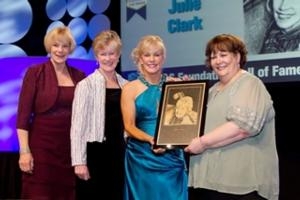Tue, Jan 24, 2012
One Of The First 21 Female Airline Pilots In North America
The evening of Wednesday, December 7, 2011, marked the closing
of the International Council of Air Shows convention where
thousands of delegates gathered for education sessions, to book air
show performers and where performers put on their “game
face” to make connections and book air show events.

Capping off that Wednesday evening was the presentation of the
2011 ICAS Foundation’s Air Show Hall of Fame induction
ceremony. The ICAS Foundation was established in 1995 to honor
those who have made a significant contribution to the air show
industry. Recognizing the industry’s top performers is one of
the clearest goals and purposes of the ICAS Foundation. That
evening, Julie E. Clark, along with Jim and Ernie Moser; Steve
Oliver and Suzanne Asbury-Oliver, were inducted into the 2011 Hall
of Fame. Julie and her fellow inductees join the ranks of air show
legends Art Scholl, Bill Barber, Bob Hoover, Betty Skelton and
Jimmy Franklin, just to name a few.
Ms. Clark’s career in aviation began with a desire to
become an airline pilot, just as her father, Captain Ernest Clark,
had been. A pilot for Pacific Airlines in the 1960’s, Captain
Ernest Clark and all on board fateful flight 773, were killed by a
deranged passenger on May 7, 1964. Prior to the days of the
required locking cockpit door, a suicidal passenger stormed the
cockpit, struggled with Captain Clark, his co-pilot and a flight
attendant before succumbing to their injuries and the eventual
crash of the airplane. Subsequent FAA regulations requiring the use
of locking cockpit doors were written for Captain Ernest Clark and
flight 773.
Undeterred by her father’s death, Julie reached her goal
and became one of the first 21 female airline pilots in North
America. Remarkably, throughout her 28 years as an airline pilot,
(achieving the title of Captain in 1983) Julie simultaneously
maintained a career as an air show pilot too! Actively
performing on the air show circuit today, Julie is looking forward
to an active 2012 air show season. Julie is the recipient of more
than 40 individual awards spanning the last three decades.
(Pictured L-R Julie’s sisters; Judy Grilli and Sharon DeVos.
Center: Julie Clark and to the right, Caroline Trinkwalder,
presenting.) (Photo courtesy of Clark Cook)
More News
Light Gun A handheld directional light signaling device which emits a brilliant narrow beam of white, green, or red light as selected by the tower controller. The color and type of>[...]
"The journey to this achievement started nearly a decade ago when a freshly commissioned Gentry, driven by a fascination with new technologies and a desire to contribute significan>[...]
Aero Linx: JAARS, Inc. For decades now, we’ve landed planes on narrow rivers and towering mountains. We’ve outfitted boats and vehicles to reach villages that rarely se>[...]
"Our driven and innovative team of military and civilian Airmen delivers combat power daily, ensuring our nation is ready today and tomorrow." Source: General Duke Richardson, AFMC>[...]
Aircraft Conflict Predicted conflict, within EDST of two aircraft, or between aircraft and airspace. A Red alert is used for conflicts when the predicted minimum separation is 5 na>[...]
 ANN's Daily Aero-Term (04.20.24): Light Gun
ANN's Daily Aero-Term (04.20.24): Light Gun Aero-News: Quote of the Day (04.20.24)
Aero-News: Quote of the Day (04.20.24) ANN's Daily Aero-Linx (04.21.24)
ANN's Daily Aero-Linx (04.21.24) Aero-News: Quote of the Day (04.21.24)
Aero-News: Quote of the Day (04.21.24) ANN's Daily Aero-Term (04.21.24): Aircraft Conflict
ANN's Daily Aero-Term (04.21.24): Aircraft Conflict



